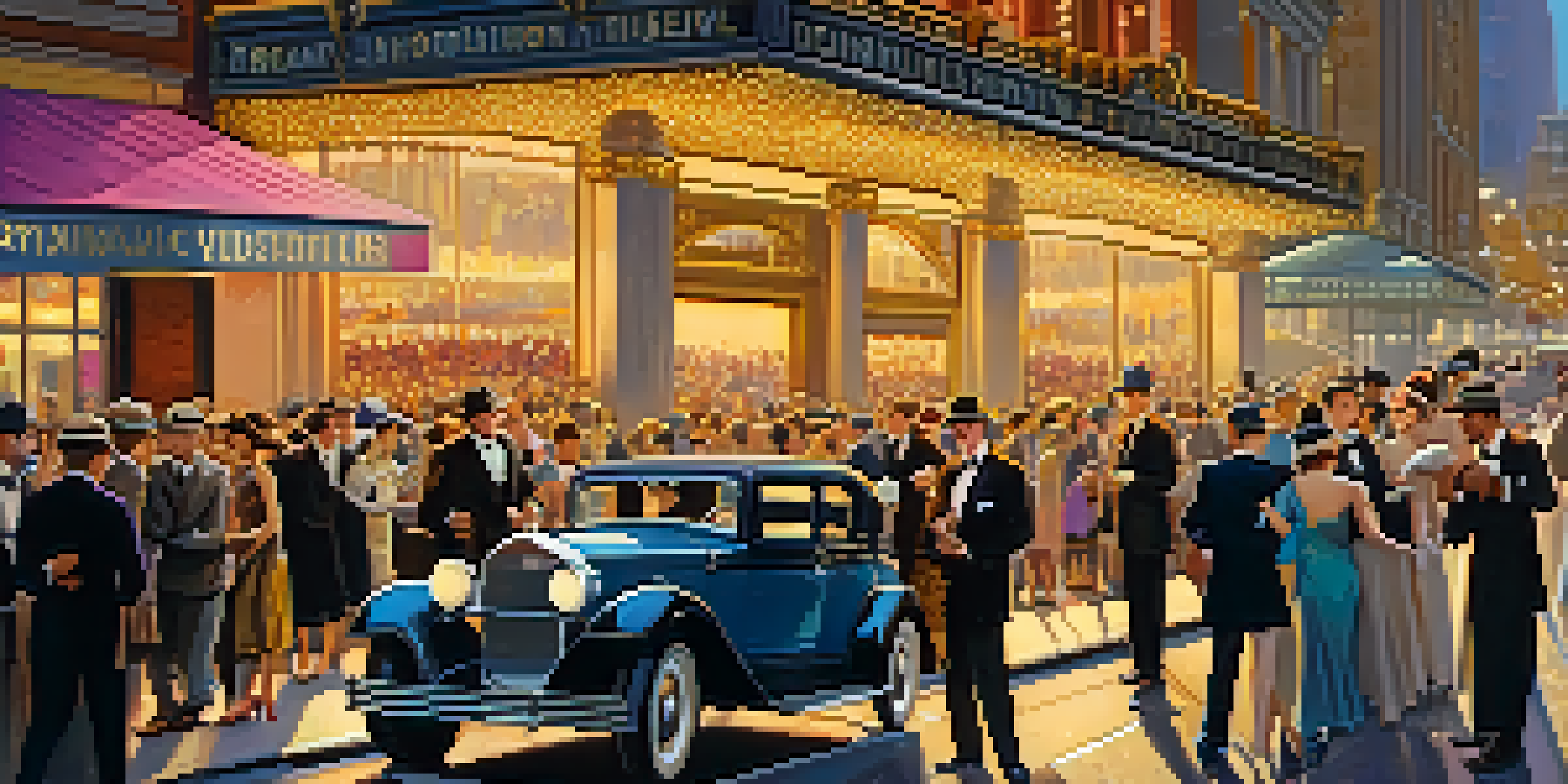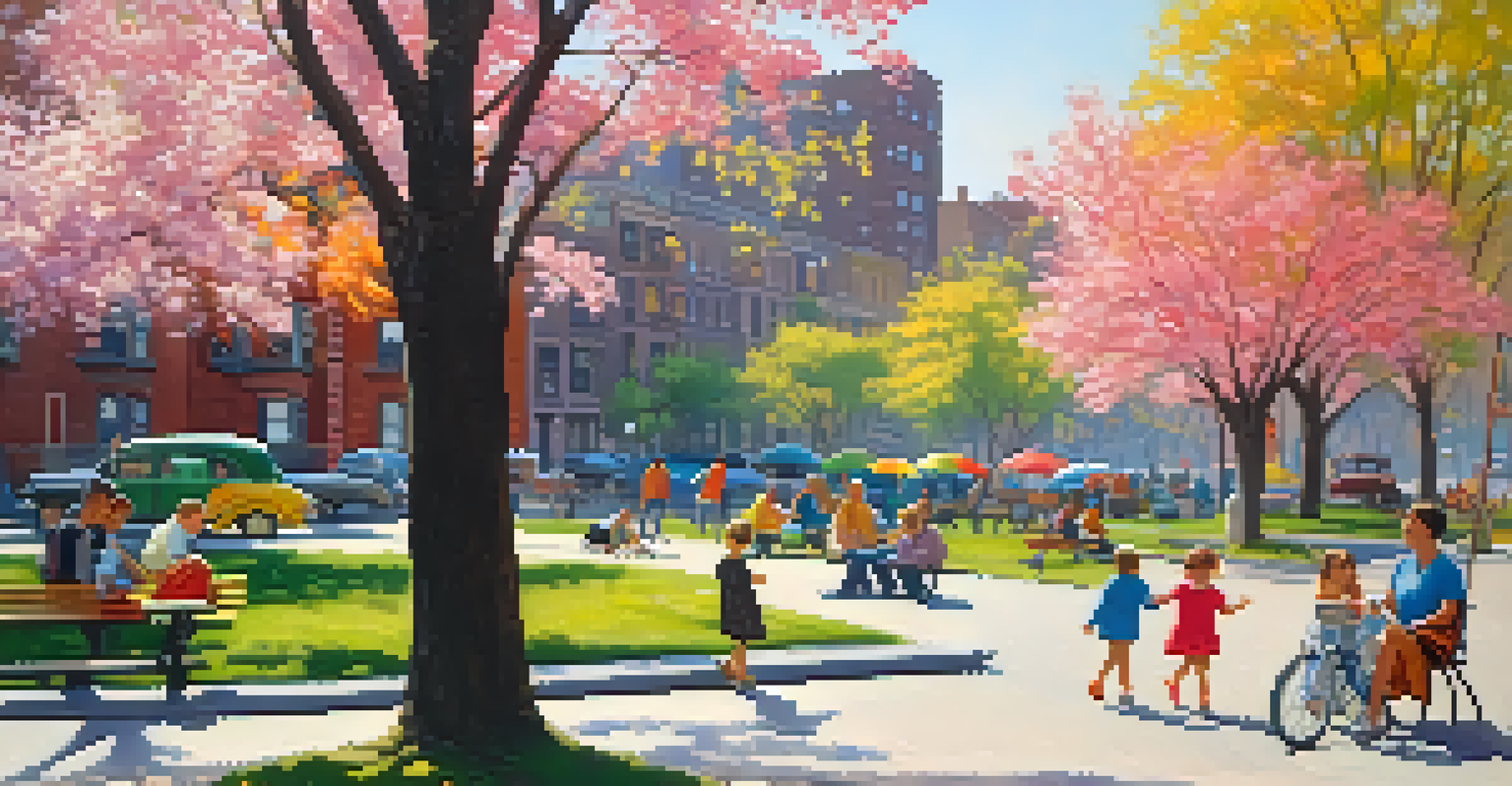The Evolution of NYC's Portrayal in Film Over the Decades

The Roaring Twenties: Glamour and Jazz in NYC Films
In the 1920s, New York City was a beacon of glamour and excitement, reflected vividly in films of the era. Movies like 'The Jazz Singer' showcased the vibrant nightlife and the cultural melting pot that was NYC, capturing the energy of the Roaring Twenties. This period marked the birth of the modern urban narrative in cinema, where the city's bustling streets became a character in its own right.
New York is not a city, it's a world.
The portrayal of NYC during this decade was often romanticized, with dazzling parties and jazz music serving as a backdrop to the stories. Filmmakers used the city to symbolize freedom and ambition, embodying the dreams of many who flocked there seeking a better life. As audiences watched these films, they fell in love with not just the characters, but the city itself.
This era laid the groundwork for how New York City would be depicted in films for decades to come. The allure of NYC as a glamorous, vibrant metropolis would continue to echo through the years, influencing countless filmmakers and shaping the public's perception of the city.
The 1930s: Tough Times and Gritty Realism
As the Great Depression hit in the 1930s, the portrayal of New York City took a drastic turn. Films began to reflect the struggles and hardships faced by many, with stories of survival and resilience becoming prominent. Movies like 'The Public Enemy' depicted the gritty underbelly of the city, showcasing the challenges of urban life during tough economic times.

This shift towards realism brought a new depth to the cinematic portrayal of the city. Instead of focusing solely on glamour, filmmakers began to explore themes of poverty, crime, and social injustice, highlighting the stark contrasts between wealth and struggle. NYC became a canvas for stories that resonated with audiences, who could see their own challenges reflected on screen.
NYC's Glamour and Grit in Film
The portrayal of New York City in films evolved from the glamorous escapism of the 1920s to the gritty realism of the 1930s and beyond.
The 1930s marked a pivotal moment in how the city was depicted in film, transitioning from a glamorous escape to a more honest representation of urban life. This evolution not only changed the narrative but also set the stage for future filmmakers to continue exploring the complexities of life in New York City.
The Post-War Boom: Optimism and the American Dream
After World War II, the portrayal of New York City in film shifted again, this time reflecting a sense of optimism and the pursuit of the American Dream. The 1950s brought a wave of films that celebrated the city's cultural diversity and economic prosperity, showcasing families and communities thriving in the bustling metropolis. Movies like 'Breakfast at Tiffany's' illustrated a glamorous, aspirational lifestyle that many longed for.
The city is a labyrinth, a place where every street has a story.
This era was marked by a sense of hope and possibility, with NYC represented as a land of opportunities. Filmmakers embraced the city’s iconic landmarks and neighborhoods, using them to symbolize success and the chance for a new beginning. The portrayal of New York became intertwined with the idea of achieving one's dreams, resonating deeply with audiences across the nation.
However, this optimism began to coexist with emerging narratives that critiqued the very dream it celebrated. As filmmakers began to delve deeper into social issues, the complexities of urban life continued to evolve in cinema, setting the stage for the tumultuous 1960s.
The 1960s: Social Change and Urban Realism
The 1960s brought significant social upheaval, and films began to reflect the changing dynamics of New York City during this transformative decade. Movies like 'Midnight Cowboy' and 'The Graduate' portrayed a more raw and unfiltered view of urban life, capturing the disillusionment and rebellion of the youth. NYC became a backdrop for stories of identity, sexuality, and societal change.
During this time, filmmakers began to address pressing social issues, including crime, race relations, and the counterculture movement. The city was depicted as a complex character, full of contradictions—both vibrant and dangerous. This era marked a departure from previous romanticized portrayals, embracing a grittier realism that resonated with audiences grappling with the complexities of modern life.
Shifting Narratives Through Decades
Each decade brought new themes, from the optimism of the post-war boom to the social upheaval of the 1960s and the excess of the 1980s.
As filmmakers pushed boundaries, they also opened up conversations about the city's role in shaping American culture. The evolution in portrayal during the 1960s set the stage for even more diverse and nuanced storytelling in the decades that followed.
The 1970s: Grit, Gangs, and Urban Decay
The 1970s saw New York City grappling with significant challenges, and this was vividly reflected in the films of the era. Movies like 'Taxi Driver' and 'The French Connection' depicted a city in turmoil, showcasing themes of violence, crime, and social disarray. Filmmakers embraced the grit and darkness of urban life, portraying NYC as a place filled with danger and desperation.
This gritty realism resonated with audiences, who were witnessing the city’s struggles firsthand. The decline of neighborhoods and the rise of gangs became central themes, with filmmakers using these narratives to critique societal issues and explore the darker side of the American Dream. The portrayal of New York became synonymous with the struggles of its inhabitants, making it a powerful subject for storytelling.
Despite the bleakness, this era also birthed a sense of resilience and hope among filmmakers and audiences alike. The complexities of life in NYC during the 1970s laid the groundwork for a new wave of filmmaking that would continue to evolve and redefine the city’s cinematic identity.
The 1980s: Glamour, Excess, and the Rise of Blockbusters
The 1980s marked a significant shift in the portrayal of New York City, as filmmakers leaned into glamour and excess, often creating larger-than-life narratives. Blockbusters like 'Ghostbusters' and 'Wall Street' showcased the city as a playground for the wealthy and powerful, highlighting its iconic skyline and vibrant culture. This era of excess painted a picture of NYC as a place where dreams could be achieved, but often at a cost.
With the rise of big-budget films, the portrayal of New York became more stylized and dramatic. The city was depicted as a backdrop for fantastical adventures and high-stakes drama, attracting audiences with its allure. This glamorization contrasted sharply with the gritty realism of the previous decades, creating a complex and dynamic cinematic landscape.
Diversity in Cinematic Storytelling
The 1990s and beyond showcased a broader range of voices, reflecting the rich diversity and complexity of urban life in NYC.
While the 1980s celebrated the city's wealth and opportunities, it also critiqued the moral implications of such excess. Filmmakers began to explore the consequences of ambition and greed, adding depth to the portrayal of NYC as a character that could uplift or destroy, depending on the choices made by its inhabitants.
The 1990s and Beyond: Diversity and New Narratives
As the 1990s rolled in, the portrayal of New York City in film began to reflect a broader diversity of voices and experiences. Movies like 'Do the Right Thing' and 'The City of Lost Children' showcased the complexity of urban life, emphasizing the rich tapestry of cultures that make up NYC. This era marked a shift towards more inclusive storytelling that resonated with an increasingly diverse audience.
Filmmakers began to explore stories that were previously marginalized, bringing attention to the lives of everyday New Yorkers. The city was portrayed not just as a backdrop for grand narratives, but as a living, breathing entity filled with unique stories. This evolution in portrayal helped to humanize the city, making it relatable and accessible to audiences across the globe.

In the decades that followed, NYC continued to evolve in its cinematic representation, embracing new technologies and storytelling methods. The city remains a symbol of resilience and creativity, reflecting the ever-changing landscape of America while continuing to inspire filmmakers and audiences alike.